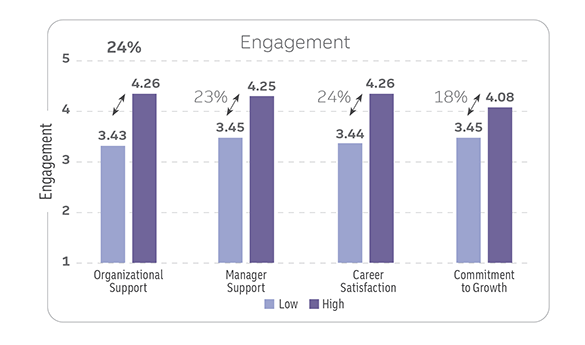
The Return on Investment of Talent Development Cultures
The evidence for investing in talent development and impact on engagement, retention, and commitment to purpose.
Written by Cheryl Flink
The global market size for training and development topped $370.3 Billion with an average spend of about $1,280 per employee in 2019 (Statista Search Department, 2023). Why do organizations spend so much money on training and development programs? Because great talent is a competitive differentiator—investments in employee growth and development can be the edge that tips new hires toward joining and current employees toward staying. The investments in training and development are necessary for developing a company’s workforce—but are insufficient without a culture focused on talent development.

Research conducted by Truist Leadership Institute identified five factors that create an effective talent development culture. The Five Factor model (see Figure 1), includes:
- The individual employee’s satisfaction with their current role and career trajectory
- The individual employee’s motivation to grow and learn
- The direct manager’s support for growth and development
- The material training and development offerings available
- The organization’s overall support for employee growth and development
The five factors make intuitive sense. However, the research also found that four of these factors have a significant, positive impact on three key outcomes: Employee intent to stay, employee engagement, and purpose.
Which factor has the least impact? The material training and development offerings. Employees' commitment to growth, their satisfaction with the progress made in their careers, and the support provided by both managers and the organization itself matter much more.
The three charts below from our national survey demonstrate this. Organizations that performed well on these four influential factors also performed well on three key outcomes: employee engagement, employee intent to stay, and employee connection to organizational purpose. Let's take a look.
In the case of engagement, organizations that offered strong support for growth and development had engagement scores almost 25% higher than organizations that offered weak support for growth and development – and that marked difference happened across the board.
Organizations that have growth-oriented employees, supportive managers, and an international culture focused on talent development have highly engaged employees who want to stay and are committed to the organization's purpose.



The message of this research? Investments in training and development are table stakes—but a return on that investment is far less likely without a vibrant learning development culture. To learn more about how to create that talent development culture, download our Creating a learning and development culture Purple Paper® : Investing in your future workforce
Connect with a Truist Leadership Institute Business Advisor.
Related resources

Mentoring: the gift is in the giving | Truist Leadership Institute
Talent development
Mentoring: the gift is in the giving
Senior Leadership Development Facilitator, Jim Kankula, helps leaders understand how and why to build impactful mentorships.
Explore how leaders can enrich their careers and organizations by mentoring, fostering employee engagement, and promoting a culture of learning.

Executive presence: disrupting leadership perceptions | Truist Leadership Institute
Talent development
Executive presence: disrupting leadership perceptions
Is the concept of “executive presence” more about the leader—or about us?
Examine the concept of executive presence and its impact on leadership effectiveness. Explore evidence challenging traditional views and discover actionable insights.
{3}

Interested in learning more?
Contact us, subscribe to our newsletter, or follow us on LinkedIn to keep the conversation going.
Connect with a Business Advisor
One of our seasoned Business Advisors can guide you through our range of offerings and help you select the best options for you, your team, or your whole organization.